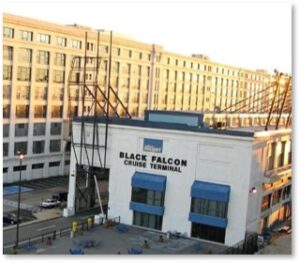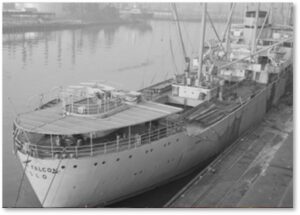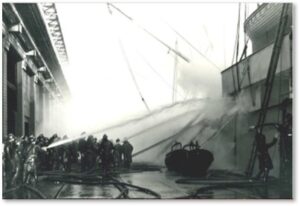Now that the pandemic is dwindling and vacationers are swarming, cruise ships have found their way back to Boston’s Black Falcon Terminal. I like this development because it means more work for tour guides like me.

The old Black Falcon Terminal
The big cruise ships dock at what used to be known as the Black Falcon Terminal in the Seaport. the city rechristened it in 2017 as the Raymond Flynn Cruiseport after former Boston mayor Raymond Flynn, who opened the cruise terminal in 1986.
I understand Boston’s preference for naming everything from buildings to bridges after politicians both alive and dead. (I’m not a fan, but that was another post.) Actually, however, I prefer the name Black Falcon Terminal. It’s so much more interesting and evocative than other names in the area, like the romantically named A Street, D Street, and Haul Road.
Finding the Answer
But where did that name come from? I have often wondered about it and, on Sunday, a tourist on my bus asked the question. I didn’t have an answer. That meant I needed to find out.

Cruise ship docked at Boston’s cruiseport
What was the Black Falcon and how did it come to give its name to a very large and important structure? The Cruiseport, located at 1 Black Falcon Avenue, is the oldest, continuously running port in the Western Hemisphere. In a normal year, it serves over 300,000 passengers.
The long, low structure parallels the Innovation Design Building and lies along the Reserved Channel. The ginormous cruise ships that dock alongside—up to three of them at one time—often dwarf it.
The Black Falcon

The Black Falcon — courtesy of the Boston Public Library
It turns out that both the terminal and the street that runs between it and the larger Innovation Design Building next door were both named, appropriately, for a ship. The Black Falcon was a 440-foot-long Norwegian merchant ship under charter to the Black Diamond Steamship Company of New York.
On November 2, 1953, when the terminal was still part of a U.S. Army base, the Black Falcon caught fire, setting off three alarms. This description of the tragedy comes from the New York Times:
“A searing explosion raked a cargo hold of the Norwegian freighter Black Falcon today, killing seven men who were trapped below by the flames and injuring thirteen others. The victims all were longshoremen.”
Fire in the Hold
The Marine Board of Investigations conducted an investigation and found that the ship loaded general cargo in Hamburg, Germany, including sodium peroxide, destined for the United States.
“The sodium peroxide was contained in approved drums which were properly labeled, explaining the nature and characteristics of the material. The 140 drums of sodium peroxide, each weighing 433 lbs., were properly stowed in the ‘tween deck of the No. 4 hold but, at Antwerp, Belgium, re-stowed to the lower hold. The sodium peroxide was not properly described on any dangerous cargo list, manifest, or other ship’s document contrary to the requirements of Chapter VI of the Convention for International Life at Sea.”
The re-stowage also violated established safety conventions. Nevertheless, the Black Falcon continued on its route and arrived in Boston on November 2, 1953. When it began unloading:
“…the covering lid of one of the drums came off in handling and a quantity of the sodium peroxide spilled through the interstices of the cargo boards and in the dunnage to the floor of the hold. Fire immediately ensued followed by explosions, and as a result, although 15 persons escaped from the hold, 8 persons lost their lives. The Boston Fire Department responded promptly and extinguished the fire with little damage to the vessel.”
Water + Sodium Peroxide = Fire

Fire in the hold — Courtesy of the Boston Public Library
Because chemistry was never my strong suit, I sought an explanation from experts. The Fire Engineering website explains that, “If a little water is added to the sodium peroxide, local heating takes place, and hydrogen peroxide, oxygen and steam are suddenly evolved. If any combustible matter is present, a fire or explosion will take place.”
Lawsuits totaling $500,000 were filed against the ship’s operators in Federal Court in behalf of the eight longshoremen who died and their families. That’s worth $5,414,026 in today’s money
No Cargo Ships Today
No cargo ships dock at the Black Falcon Terminal/Raymond Flynn Cruiseport these days; and only tourists disembark with their luggage. We no longer have to worry about accidental chemical reactions that explode. And that’s a good thing.
Now I can explain the name of the place to any curious tourists who want to know. And now you know, too.

Thank you for the interesting story. One correction – I think you meant to write that the pier was rechristened in 2017, not 1917 (would make an interesting time-travel story if that were the case).
Yes, you are one of several observant people who caught that error. It has been fixed. Thank you for writing.